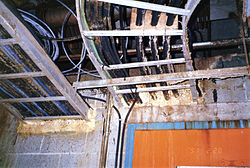
Back قانون البناء Arabic ভবন নির্মাণ নীতিমালা Bengali/Bangla Codi d'edificació Catalan Código de edificación Spanish Eraikuntza kode Basque ضوابط ساختوساز ساختمان Persian Document technique unifié French निर्माण संहिता Hindi Peraturan bangunan ID Statybos teisė Lithuanian
The examples and perspective in this article may not represent a worldwide view of the subject. (November 2021) |

A building code (also building control or building regulations) is a set of rules that specify the standards for construction objects such as buildings and non-building structures. Buildings must conform to the code to obtain planning permission, usually from a local council. The main purpose of building codes is to protect public health, safety and general welfare as they relate to the construction and occupancy of buildings and structures — for example, the building codes in many countries require engineers to consider the effects of soil liquefaction in the design of new buildings.[1] The building code becomes law of a particular jurisdiction when formally enacted by the appropriate governmental or private authority.[2]
Building codes are generally intended to be applied by architects, engineers, interior designers, constructors and regulators but are also used for various purposes by safety inspectors, environmental scientists, real estate developers, subcontractors, manufacturers of building products and materials, insurance companies, facility managers, tenants, and others. Codes regulate the design and construction of structures where adopted into law.
Examples of building codes began in ancient times.[3] In the USA the main codes are the International Building Code or International Residential Code [IBC/IRC], electrical codes and plumbing, mechanical codes. Fifty states and the District of Columbia have adopted the I-Codes at the state or jurisdictional level.[4] In Canada, national model codes are published by the National Research Council of Canada.[5] In the United Kingdom, compliance with Building Regulations is monitored by building control bodies, either Approved Inspectors or Local Authority Building Control departments. Building Control regularisation charges apply in case work is undertaken which should have had been inspected at the time of the work if this was not done.[6]
- ^ CEN (2004). EN1998-5:2004 Eurocode 8: Design of structures for earthquake resistance, part 5: Foundations, retaining structures and geotechnical aspects. Brussels: European Committee for Standardization.
- ^ Ching, Francis D. K.; Winkel, Steven R. (22 March 2016). Building Codes Illustrated: A Guide to Understanding the 2015 International Building Code. John Wiley & Sons. ISBN 978-1-119-15095-4.
- ^ "Hammurabi's Code of Laws". eawc.evansville.edu. Archived from the original on 9 May 2008. Retrieved 24 May 2008.
- ^ "About ICC". www.iccsafe.org. Retrieved 8 December 2013.
- ^ Canada, Government of Canada. National Research Council. "Codes Canada - National Research Council Canada". www.nrc-cnrc.gc.ca. Retrieved 1 April 2018.
- ^ Northampton Borough Council, Building Control - regularisation charges www.northampton.gov.uk Archived 11 May 2021 at the Wayback Machine, accessed 15 March 2021
© MMXXIII Rich X Search. We shall prevail. All rights reserved. Rich X Search